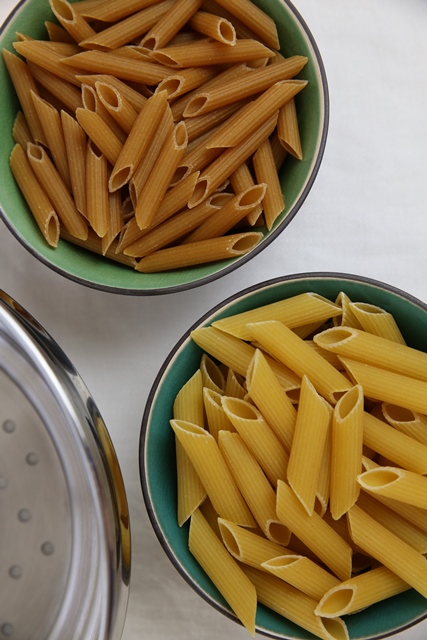Product Snapshot: Barilla whole grain penne pasta
Written by Catherine Saxelby
on Monday, 14 April 2014.
Tagged: healthy cooking, healthy eating, Product snapshot, whole grains

From breakfast cereals to breads, I’m a big fan of eating whole grains but when it comes to pasta, whole grain or high-fibre versions have been, well, pretty dreadful. In the past, I’ve cooked up pastas that have been dark, thick and heavy. They made eating feel like hard work. Any time I’d try and sneak them past the husband, he’d pick them straight away.
So Barilla’s latest effort is a pleasing improvement in taste and texture from these heavy-duty pastas of days gone by – a feat of food technology that I’d expect from their on-pack boast that they are ‘Italy’s No 1 brand of pasta’.
Source of whole grain and fibre
Barilla’s whole grain duo – the penne and spaghetti - derive their whole grain content from a blend of whole wheat durum flour and oat fibre. There’s also the traditional semolina as well as regular durum flour (think white flour).
Barilla – mercifully - hasn’t tried to make it 100 per cent wholegrain as the ones in the past have done. Rather they’ve gone for a get-it-over-the-line tactic so they only claim 51 per cent whole grain, which means the pasta is much more acceptable in mouth feel.
It also boasts a high 10 per cent fibre - which is on a par with breakfast biscuits, many mueslis, dates and prunes.
Compared to the white, the whole grain penne looks browner but if you cook it a little longer, it cooks up to the same pleasant texture. It contains around three times more fibre than ordinary white pasta as well as more minerals (iron, magnesium, phosphorus) and B vitamins (thiamin, folate).
Stronger flavour, stronger sauces
Team this pasta with robust sauces based on olives, pesto, meat sauces, mussels, artichoke hearts, spinach, walnuts or pistachios and you won’t be disappointed.
In the US where this penne is made, Barilla have more varieties such as Longs - think spaghetti (both regular and thin) - Angel Hair and Linguine (which is a big fave of mine) and Shorts such as Elbows, Medium Shells and Rotini (corkscrews).
In Australia we have to content ourselves with just the penne and the spaghetti for now. If they become popular then no doubt they’ll expand the range.
Nutrition figures from the label
Per 100 g uncooked
1456 kJ (348 Cals), 13 g protein, 2.5 g fat (including 0.5 g saturated fat), 62.5 g carbohydrate (including 3.5 g sugars), 10 g fibre, 15 mg sodium as well as iron, magnesium, phosphorus.
Ingredients from the label
Whole grain durum wheat flour, semolina (wheat), durum wheat flour, oat fiber.
(Note US spelling as this product is made in USA where their labelling laws are more similar to ours than in Italy)
PROs
- Convenient way to boost your whole grains for their health benefits
- Convenient way to boost your fibre without bran or cereal
- Smaller 375 g pack size, down from the usual 500 g, so easier to store in a small kitchen
- Good texture
- Cooks and performs just like any other pasta
- Available in supermarkets and Italian supermarkets.
CONs
- Darker colour - may be refused by picky eaters
- Costs 50 per cent per kilogram MORE than the regular pasta
The bottom line
Pleasant al dente eating with a mild nuttiness that doesn’t scream ‘grainy’. Here’s another new product that helps us eat more whole grains and more fibre, which, as Australians, we don’t eat enough of. Yes there are other whole grain pastas but these two make it easy to swap from regular (white) penne.
You may also be interested in...
Like to have your product reviewed by Catherine?
 This post was researched and written by Catherine Saxelby, an accredited nutritionist, dietitian, author and award-winning food communicator. Catherine's goal is to help busy working women eat well, maintain a healthy weight and boost their energy.
This post was researched and written by Catherine Saxelby, an accredited nutritionist, dietitian, author and award-winning food communicator. Catherine's goal is to help busy working women eat well, maintain a healthy weight and boost their energy.
Checkout Catherine’s other posts, books and product reviews or sign up for her free Foodwatch newsletter. To have your product or service reviewed by Catherine and her team, click here.
Sign up for Catherine's free Foodwatch newsletter
About the Author
Catherine Saxelby has the answers! She is an accredited nutritionist, blogger and award-winning author. Her award-winning book My Nutritionary will help you cut through the jargon. Do you know your MCTs from your LCTs? How about sterols from stanols? What’s the difference between glucose and dextrose? Or probiotics and prebiotics? What additive is number 330? How safe is acesulfame K? If you find yourself confused by food labels, grab your copy of Catherine Saxelby’s comprehensive guide My Nutritionary NOW!
The Good Stuff
The Boring Stuff
© 2023 Foodwatch Australia. All rights reserved
Author photo by Kate Williams
Website by Joomstore eCommerce










